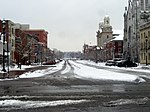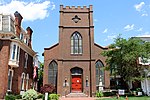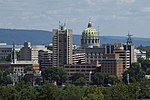Market Street Bridge (Susquehanna River)
1928 establishments in PennsylvaniaBridges completed in 1928Bridges in Cumberland County, PennsylvaniaBridges in Harrisburg, PennsylvaniaBridges over the Susquehanna River ... and 5 more
Former toll bridges in PennsylvaniaHistoric American Engineering Record in PennsylvaniaNational Register of Historic Places in Cumberland County, PennsylvaniaRoad bridges on the National Register of Historic Places in PennsylvaniaStone arch bridges in the United States

The Market Street Bridge is a stone arch bridge that spans the Susquehanna River between Harrisburg, Pennsylvania, and Wormleysburg, Pennsylvania. The current structure is the third bridge built at its current location and is the second oldest remaining bridge in Harrisburg. The bridge carries BicyclePA Route J across the river. The bridge was listed on the National Register of Historic Places on June 22, 1988 and was documented by the Historic American Engineering Record in 1997.
Excerpt from the Wikipedia article Market Street Bridge (Susquehanna River) (License: CC BY-SA 3.0, Authors, Images).Market Street Bridge (Susquehanna River)
Market Street Bridge, Harrisburg
Geographical coordinates (GPS) Address Nearby Places Show on map
Geographical coordinates (GPS)
| Latitude | Longitude |
|---|---|
| N 40.256666666667 ° | E -76.884722222222 ° |
Address
Market Street Bridge
Market Street Bridge
17101 Harrisburg
Pennsylvania, United States
Open on Google Maps









